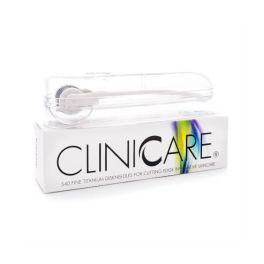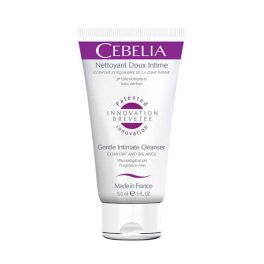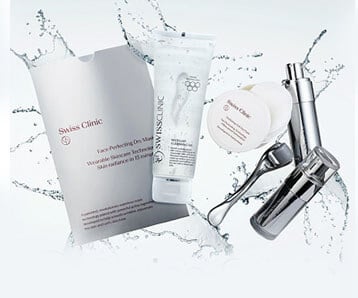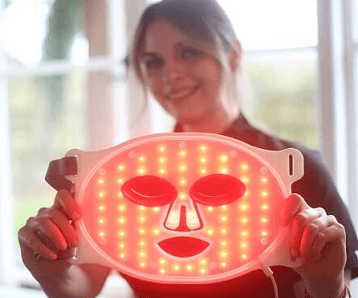What is Dermalux Flex MD? Posted on 20 Oct 2010
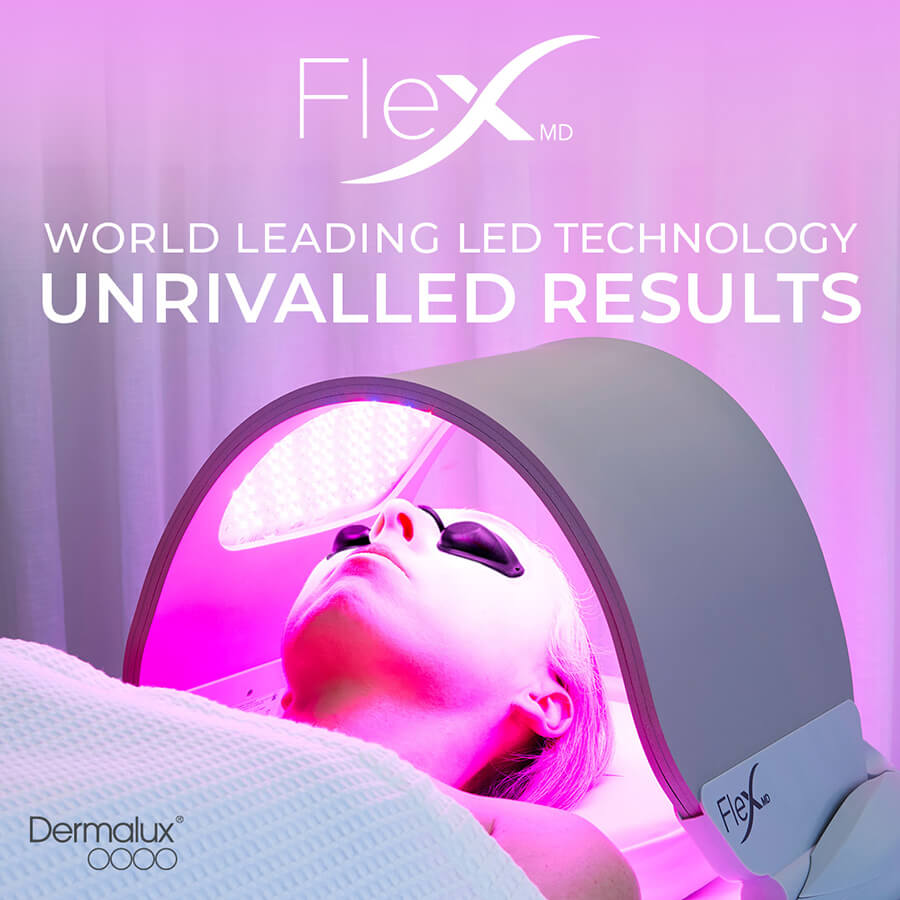
What is Dermalux Flex MD?
Dermalux Flex MD is a non-invasive treatment that delivers clinically proven therapeutic light energy for rejuvenating
and corrective benefits. Specific wavelengths are absorbed by the skin to stimulate cell renewal and collagen
production, resolve problem skin conditions such as acne and redness and accelerate skin healing. It is a safe and
pain free treatment without downtime.
Following a single Flex MD session, clients can expect immediate improvement in skin tone, hydration and luminosity
whilst the beneficial light simultaneously stimulates deeper cell processes for longer lasting benefits in the skin. For
sensitive skin conditions, the Flex MD offers relief with redness and irritation.
The Flex MD is an essential treatment for optimum skin health and wellbeing as part of a regular skin care routine. It is
also recommended in combination with skin treatments to enhance and accelerate results.
Dermalux Flex MD is a medically CE certified device for the treatment of acne, psoriasis, wound healing and
musculoskeletal pain. Cosmetic indications include skin rejuvenation, pigmentation, redness and sensitive skin conditions.

Dermalux wavelengths
The Dermalux Flex MD delivers Blue 415nm, Red 633nm and Near Infrared 830nm which are the industry
leading and most clinically evidenced wavelengths for the LED Phototherapy treatment.
Each wavelength of light is absorbed by a different target chromophore to stimulate specific skin enhancing
processes with proven therapeutic effects.
Dermalux enables these beneficial wavelengths to be delivered in single or multi-wavelength mode via seven
protocol options, offering a tailored and adaptable treatment approach. Multi-wavelength treatments target a
range of indications in one session for maximum skin enhancing results.
Blue Light 415nm (penetration up to 1mm)
KEY MECHANISM: ANTI-BACTERIAL
Blemish fighting blue light destroys the bacteria which causes acne and helps in the prevention of breakouts. Blue light is absorbed by p.acnes bacteria and triggers a natural photochemical reaction releasing singlet oxygen. Singlet oxygen has a powerful antibacterial action to help eliminate spots whilst being gentle on the skin. It also helps to balance oil production and improve skin clarity. Applied in combination with Red and Near Infrared light, the Dermalux Flex MD treatment offers enhanced results for acne and is excellent as a post-treatment procedure to help minimise breakouts and reduce redness.
Red Light 633nm (penetration 2 to 3mm)
3.3 Near Infrared Light 830nm (penetration 5 to 10mm)
KEY MECHANISM: REJUVENATION AND CELL RENEWAL
Rejuvenating Red light accelerates cell renewal and repair, boosting collagen and elastin synthesis for smoother
firmer skin. Red light is absorbed in the cell mitochondria and stimulates the synthesis of Adenosine Triphosphate (ATP), an essential energy for cellular function.
Supercharging our cells triggers a cascade of beneficial biological reactions which result in a range skin skin-enhancing effects. Skin cells that are energised function better can regenerate up to 200% faster.
Red light is potently absorbed by fibroblasts increasing collagen and elastin synthesis and boosting hydration levels.
Improved blood flow brings increased tissue oxygenation to accelerate repair whilst stimulation of the lymphatic systems helps with detoxification.
Red light offers immediate improvement in skin tone, hydration and vitality whilst the beneficial light simultaneously stimulates cellular processes for long lasting benefits in appearance and health of the skin.
KEY MECHANISM: WOUND HEALING ACTION
Near Infrared light is absorbed in the skins deepest layers and works synergistically with Red light for optimum rejuvenation results.
Exposure to Near Infrared light at 830nm increases blood circulation bringing vital oxygen and nutrients to help modulate inflammation, accelerate wound healing, calm irritation and reduce redness.
Near Infrared light builds strength and integrity for compromised, environmentally damaged and sensitive skin conditions. It is also clinically effective in the treatment of hyperpigmentation.
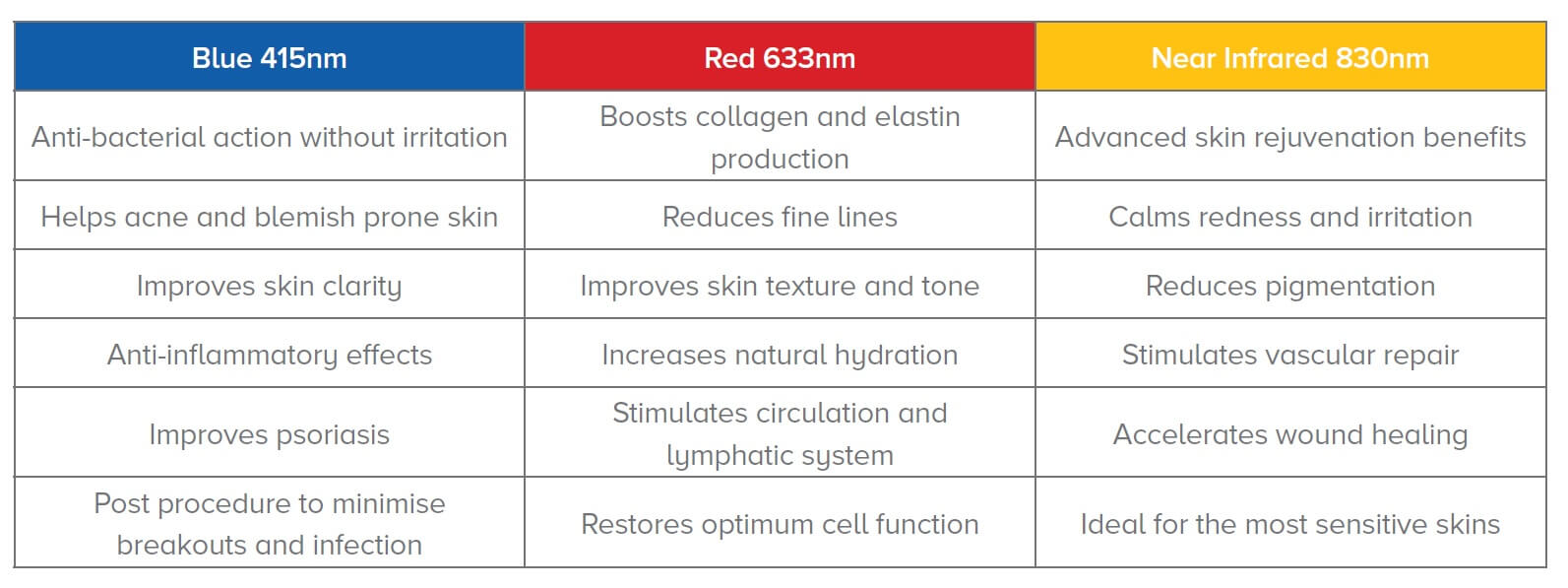
Indications for Use:
• Skin Rejuvenation
• Complexion
• Dry Skin
• Pigmentation: Photo-damage
• Pigmentation
• Acne: Mild to Moderate
• Acne: Moderate to Severe
• Redness: Vascular
• Redness: Skin Tone
• Sensitive Skin
• Sensitive Skin: Problem conditions
• Psoriasis
• Wound Healing
• Pain
How many Treatments?
These include age, skin type, severity of indication, lifestyle factors and other procedures that may be included in the overall treatment programme.
COURSE RECOMMENDATION: 12 Flex MD treatments are generally recommended for all indications at a frequency of 2 sessions per week. Clients should be reviewed at the end of the course to assess progress and further treatments may then be advised as required.
TREATMENT FREQUENCY: A 24-hour time period between treatments is generally recommended for inflammatory conditions such as acne, redness and sensitive skin however for general skin rejuvenation, treatments can be taken in daily succession.
COURSE FREQUENCY: Due to cell activation, results can last for several weeks following a course of Dermalux treatments. However, regular maintenance treatments are advised to extend results as part of an on-going skin health programme.
Dermalux Flex MD can be recommended in 3 ways: Activate, Boost and Combine.
1/ ACTIVATE - Intensive skin activation programme. 12 treatments recommended 2 to 3 times per week for optimum results. Once completed recommend regular maintenance treatments.
2/ BOOST - Individual treatments or short booster course of 3 sessions to revitalise and restore vitality or calm irritation. Recommend as a boost before a special event.
3/ COMBINE - Integrated or post treatment application to enhance and accelerate results.
Dermalux Flex MD with Topical Skin Care Products
Certain topical products may be applied to the skin prior to the Dermalux Flex MD treatment as part of bespoke protocol.
For best results, apply topicals that can be readily absorbed by the skin such as a water-based serums and low-viscosity gels. Growth factots, Stem cells , Peptides or Hyaluronic Acid Serums.
Opaque creams, oil-based products and cream/clay based masks will create a barrier and inhibit the penetration of beneficial light into the skin and potentially diminish results.
Applying topical products to the skin prior to the Dermalux treatment offers a number of key benefits:
• Near Infrared 830nm can enhance cell permeability which aids product penetration whilst Red 633nm is proven to increase cell metabolism which can accelerate activation of ingredients.
• The skin is not totally smooth and dead skin cells create an uneven surface which increases the reflection of light. Topical serums help to create a more homogenous skin surface that allows for more even and enhanced light absorption.
Dermalux Flex MD Treatment Times
For optimum results, the Flex MD treatments are pre-set to a 30-minute duration and can be manually adjusted as required.
As a combination protocol where the skin has been activated by another procedure, the recommended treatment time is 20-minutes.
This is selected manually on the Flex MD controller by stopping the time after a 20-minute duration.
For all Body treatments where the Flex MD canopy is in close proximity to the skin, the recommended treatment time is 20-minutes.
This is selected manually on the Flex MD controller by stopping the time after a 20-minute duration.
Eye Safety:
It is recommended that the supplied eye protector goggles should be worn by the client for all Flex MD protocols and for the duration of the LED treatment.
When fitting the goggles, ensure that the pupils are protected from direct illumination. For additional safety, the client should be instructed to close their eyes.
For clients who are highly sensitive to the LED light, gauze or cotton pads may be placed over the direct eye area under the goggles for additional protection.
It is safe to wear contact lenses during treatment.
TREATMENT:
STEP 1: Cleanse
Cleanse with appropriate cleanser for skin type and indications. Ensure all traces of makeup and product residue are removed as this can inhibit light absorption.
STEP 2: Exfoliate
Exfoliate to remove superficial dead skin cells. Avoid this step for sensitive skin conditions. Exfoliation is not required if the Flex MD is being combined with another exfoliating/resurfacing procedure.
STEP 3: Correct
Correct (recommended optional step). Apply a treatment serum to the skin for additional skin conditioning benefits. Avoid this step for sensitive skin conditions.
STEP 4: Massage Massage the serum into the skin for 1 to 2 minutes to stimulate blood flow.
STEP 5: Prepare Prepare Flex MD for treatment application
STEP 6: Position
Apply eye wear (provided) to client. For additional comfort, the client should be instructed to close their eyes.
STEP 7: Eye Wear Position Flex MD over treatment area.
STEP 8: Wavelength
Select the required wavelength protocol. Warn the client that the treatment is about to commence. Press Start to activate the Flex MD.
STEP 9: Assess
At the end of the treatment, remove the client goggles and assess the skin. Due to activation, the skin may appear slightly flushed immediately after the Flex MD treatment which is normal and transient.
STEP 10: Hydrate
Apply appropriate skin care products for the skin type and indication including an SPF (during daylight hours).














